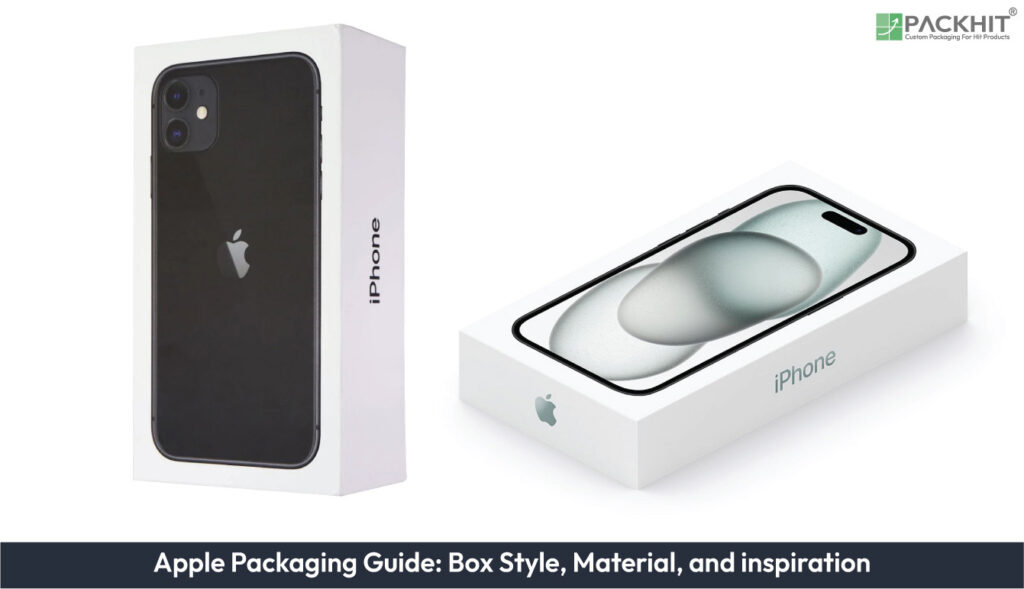Apple’s packaging design exemplifies innovation through a blend of functionality, sustainability, and brand integrity. The company uses varied box styles tailored to product categories—rigid boxes for flagship items like iPhones, slipcases for compact accessories, and folding cartons for smaller products. Materials such as fiberboard, molded pulp, and kraft paper, complemented by eco-friendly coatings, reinforce Apple’s commitment to sustainability. By eliminating plastic, incorporating recycled components, and optimizing packaging for shipping efficiency, Apple reduces environmental impact. The design principles of Apple’s packaging emphasize simplicity, functionality, and brand consistency, with clean aesthetics and uniform branding elements enhancing user experience and reinforcing its premium image.
What Box Styles Does Apple Use for Packaging?
The box styles used by Apple for packaging are mentioned below:
Rigid Boxes
Rigid boxes are a cornerstone of Apple’s packaging design, often employed for flagship products like iPhones and MacBooks. These boxes are engineered for superior structural integrity, creating a durable and premium unboxing experience. The snug-fitting lid and base mechanism of rigid boxes provide a controlled opening experience, enhancing the perceived value of the product while ensuring protection during transit.
Slipcases
Slipcases are another key box style, typically used for accessories such as headphones and smaller gadgets. Designed to be compact and sleek, slipcases balance aesthetic appeal with material efficiency. Their minimalist design reduces material usage while maintaining a polished appearance, making them an ideal choice for products that require lightweight and portable packaging solutions.
Folding Cartons
Folding cartons are utilized for smaller items like cables, adapters, and other compact accessories. These cartons are lightweight, cost-effective, and emphasize portability. Apple’s folding cartons are engineered with precision to optimize ease of storage and transportation while maintaining the brand’s high standards for visual and tactile appeal.
Each box style is meticulously designed to ensure product protection during transit while enhancing the tactile and visual experience for consumers. By tailoring box styles to the specific dimensions and requirements of each product, Apple achieves a harmonious blend of functionality, aesthetics, and sustainability in its packaging solutions.
What Materials Are Used in Apple Packaging?
Apple prioritizes sustainable materials in its packaging, with a focus on paper-based components and recycled materials, which are given below:
Fiberboard
Fiberboard is a primary material in Apple’s packaging, particularly for rigid boxes. Known for its high durability and smooth surface, fiberboard is ideal for printing and embossing, enabling Apple to achieve sleek and visually appealing designs. Additionally, this material ensures structural integrity, protecting products during transit while maintaining a premium feel.
Molded Pulp
Molded pulp is extensively used for internal trays that provide cushioning for delicate items. Derived from recycled paper, this eco-friendly material embodies Apple’s commitment to sustainability. Molded pulp is versatile and lightweight, making it suitable for securely housing components such as cables and adapters while reducing material waste.
Kraft Paper
Kraft paper is employed for wrapping and inserts, offering a lightweight and biodegradable solution. This material aligns with Apple’s environmental goals by being recyclable and compostable. Its texture and finish add a natural aesthetic to the packaging, subtly reinforcing Apple’s sustainability-focused branding.
Coatings and Finishes
Apple enhances the visual appeal of its packaging with sustainable coatings and finishes. Aqueous coatings and soy-based inks are applied to ensure recyclability while maintaining the high-quality appearance consumers expect. For example, the glossy finish on iPhone boxes is achieved using water-based coatings that do not hinder the recyclability of fiberboard. This approach balances aesthetic excellence with environmental responsibility.
How Does Apple Ensure Sustainability in Packaging Design?
Apple’s packaging strategy is deeply rooted in sustainability, with a commitment to reducing environmental impact across its supply chain. The company has eliminated plastic from most packaging components, replacing it with paper-based alternatives. For example, the plastic screen protector previously used in iPhone boxes has been replaced with a paper-based wrap. Additionally, Apple uses recycled materials extensively, with over 90% of the fiber in its packaging sourced from recycled or responsibly managed forests.
Apple also designs its packaging to minimize waste and optimize shipping efficiency. By reducing the size and weight of packaging, the company lowers transportation emissions and material usage. The compact design of the iPhone box, for instance, allows more units to be shipped per pallet, reducing the carbon footprint associated with logistics.
What Design Principles Inspire Apple’s Packaging?
Apple’s packaging design is guided by principles of simplicity, functionality, and brand consistency. The minimalist aesthetic, characterized by clean lines and monochromatic color schemes, reflects the company’s broader design philosophy. Functionality is prioritized through features such as easy-open mechanisms and protective internal structures, ensuring a seamless user experience.
Brand consistency is achieved through the use of uniform typography, color palettes, and logo placement across all packaging. For example, the Apple logo is prominently displayed on the lid of rigid boxes, serving as a focal point that reinforces brand identity. The packaging also incorporates subtle design elements, such as embossed textures and foil stamping, to enhance the tactile experience and convey a sense of luxury.

